Famous Spring Paintings – Top 10 Paintings of the Season
Spring has always been a popular theme in art history that often explored the beginnings of new life and the romantic nature of our fascination with the season. The season of spring is no doubt the perfect season to represent in art, especially when the concept of an artwork deals with nature, love, purity, beauty, and renewal. In this article, we will introduce you to the top 10 most famous spring paintings in history that capture the triumph of light over darkness through the many representations of spring.
Contents
- 1 The Symbolism of Spring in Art
- 2 Exploring the Top 10 Most Famous Spring Paintings
- 2.1 Early Spring (1072) by Guo Xi
- 2.2 Primavera (c. 1482) by Sandro Botticelli
- 2.3 Spring (1563) by Giuseppe Arcimboldo
- 2.4 Spring Bouquet (1866) by Pierre-Auguste Renoir
- 2.5 Springtime (1872) by Claude Monet
- 2.6 Fishing in Spring, the Pont de Clichy (Asnires) (1887) by Vincent van Gogh
- 2.7 Almond Blossoms (1888 – 1890) by Vincent van Gogh
- 2.8 Spring (1894) by Lawrence Alma-Tadema
- 2.9 The Artist’s Garden at Giverny (1900) by Claude Monet
- 2.10 The First Days of Spring (1929) by Salvador Dalí
- 3 Frequently Asked Questions
The Symbolism of Spring in Art
From artists like Claude Monet to Sandro Botticelli and Paul Gauguin, the allure of spring has appealed to many in art history. But what was so special about this season, and what does it symbolize? In spring art, painting has been the most common medium through which many artists have depicted complex symbols and concepts. The season of spring has numerous connotations that explore the themes of frivolity, beauty, purity, and renewal after the cycle of winter, which contrasts the aforementioned themes with themes of darkness, death, and transformation.
Ultimately, spring has been used as a universal symbol of life and all things positive represented by color palettes that include orange-tinted reds, warm greens, pale beige, and peachy pink.
Since Greek and Roman mythology was a popular subject for artists to explore, one might also look to the deity of Spring, who was called Flora in Roman mythology, and was the personification of the spring season. As such, many artists used spring to describe young women romantically, while romanticizing landscapes. In literature, spring symbolizes development and growth, which is also reflected in the natural occurrences associated with the season, when the Earth’s flora and fauna blossom after the cycle of harsh winter.
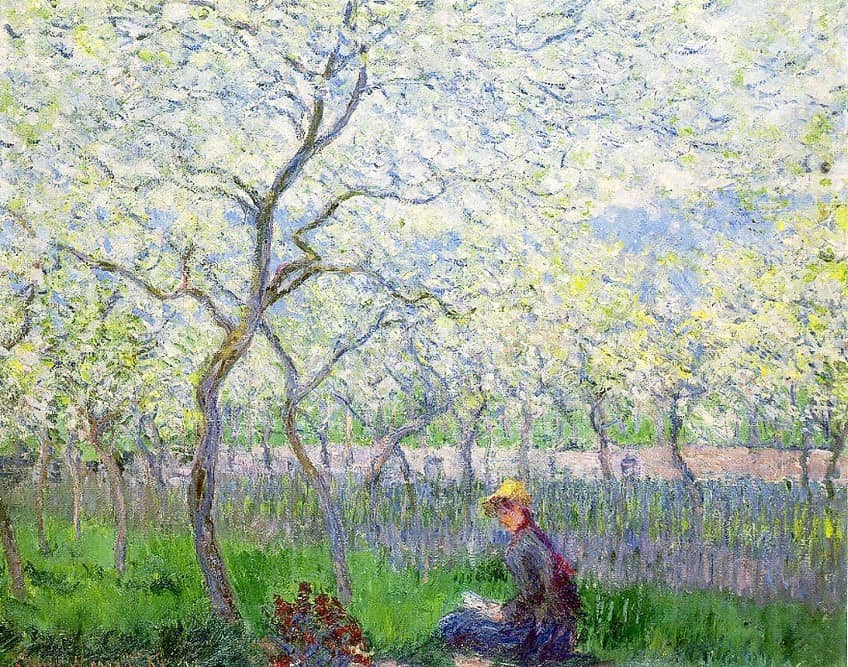
In spring art, paintings involving specific Greek and Roman mythologies have also been associated with narratives featuring the mythological figures Proserpina and Persephone. Persephone, in Greek mythology, was the daughter of Demeter, who was the goddess of fertility. According to the Greek narrative, Persephone was abducted by Hades, which caused Demeter to grieve over the absence of her daughter. As such, the Earth became barren and was plunged into winter. Upon Persephone’s return to Demeter, the earth saw a rebirth of luscious flowers and plants, which symbolized spring. Similarly, in Roman mythology, Persephone was perceived as Proserpina with a similar narrative, which follows her abduction by Pluto, who carries her to the underworld. Additionally, spring art has also embodied the cyclical rhythm of life, as it emerges from the dormancy of winter.
Throughout the centuries, artists have used imagery related to spring to convey themes such as the passage of time, and images such as the blossoming of flowers, vibrant colors, and lush landscapes to represent the symbols of spring and highlight the human experience of witnessing the rejuvenation of nature.
As such, nature also mirrors the human experience of overcoming adversities in real life. Many Renaissance depictions of spring also mimic our desire for transformation in the cycle of life. By leveraging the season of spring as a topic in art, artists have been able to produce universal and timeless paintings that appeal to our basic human desires.
Exploring the Top 10 Most Famous Spring Paintings
Now that you have an idea of the symbolism of spring in art, you can now appreciate a selection of the top 10 most famous paintings of spring. From works by Giuseppe Arcimboldo to Vincent van Gogh, you can be sure to enjoy these stunning spring artworks and paintings!
Early Spring (1072) by Guo Xi
| Artist Name | Guo Xi (1020 – 1090) |
| Date | 1072 |
| Medium | Ink and light color on silk hanging scroll |
| Dimensions (cm) | 158.3 x 108.1 |
| Where It Is Housed | National Palace Museum, New Taipei, Taiwan |
This incredible silk hanging scroll ink painting was created by Guo Xi in 1072. The painting depicts the emerging landscape amid the mist of an early spring day. The vertically oriented scroll also enables the viewer’s eyes to explore the depths of the scene while admiring the trees and vegetation that seem to awaken from the eerie mist. Guo Xi was a renowned Chinese painter, who thrived during the Northern Song Dynasty, creating many unique landscape paintings that conveyed the beauty of the shifting seasons, including spring. By studying the way artists have depicted the season, one can get an understanding of the aesthetics that artists used to convey certain themes.
In Early Spring, Xi used an S-shaped structure to form the middle ground and emphasize the pine trees and rock forms in the foreground.
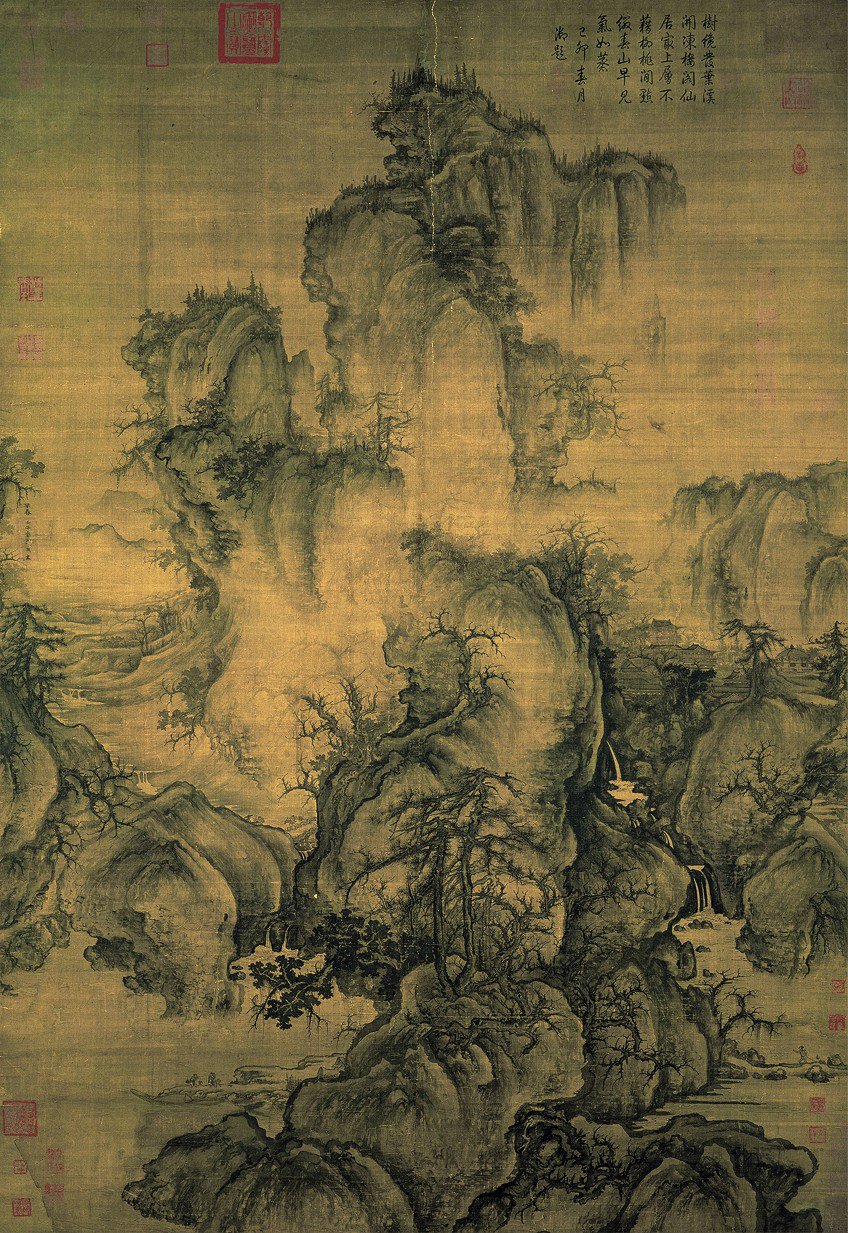
His handling of the ink also complemented the landscape as a scene in that one can fill in the blank spaces with one’s imagination. Other famous Chinese painters such as Qi Baishi and Wu Guanzhong also explored the beauty of spring in their respective practices through the use of traditional Chinese painting techniques combined with the influences of Western styles.
Primavera (c. 1482) by Sandro Botticelli
| Artist Name | Alessandro di Mariano di Vanni Filipepi (professionally known as Sandro Botticelli) (1445 – 1510) |
| Date | c. 1482 |
| Medium | Tempera on panel |
| Dimensions (cm) | 202 x 314 |
| Where It Is Housed | Uffizi Gallery, Florence, Italy |
Believed to have been a commissioned piece by the Medici family, Primavera is one of the most famous paintings of spring that has also been dubbed one of the most controversial paintings created by Sandro Botticelli. The monumental painting was created between the 1470s and 1480s, with tempera paint to portray various figures from classical mythology in an allegorical representation of spring.
What made this painting stand out was its scale, which had not been seen since classical antiquity. The painting was first described by Giorgio Vasari as “primavera” in the 16th century, who encountered the painting at the Villa Castello.
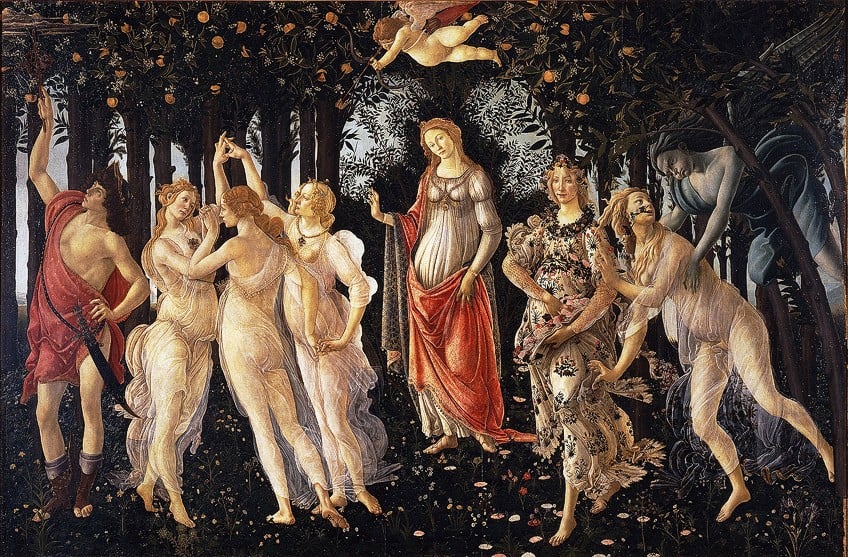
Scholars also believe that the painting’s subject may have been a reference to a poem written by Poliziano, who worked as a poet for the Medici’s and is believed to have assisted Botticelli with planning the composition. Other themes associated with the painting include fertility and Neoplatonic love.
Spring (1563) by Giuseppe Arcimboldo
| Artist Name | Giuseppe Arcimboldo (1526 – 1593) |
| Date | 1563 |
| Medium | Oil on wood |
| Dimensions (cm) | 66 x 50 |
| Where It Is Housed | Real Academia de Bellas Artes de San Fernando, Madrid, Spain |
Spring by Guiseppe Arcimboldo is one of the most famous spring paintings that is understood as an allegorical artwork. The painting portrays the side profile of a young woman that appears to be the personification of spring. Arcimboldo created the painting using the style of the Late Renaissance or Mannerist style that shows the woman’s skin represented using roses for her flushed cheeks and white blossoms for her complexion.
Arcimboldo also used different spring blossoms to portray her hair, while skillfully outlining her silhouette.
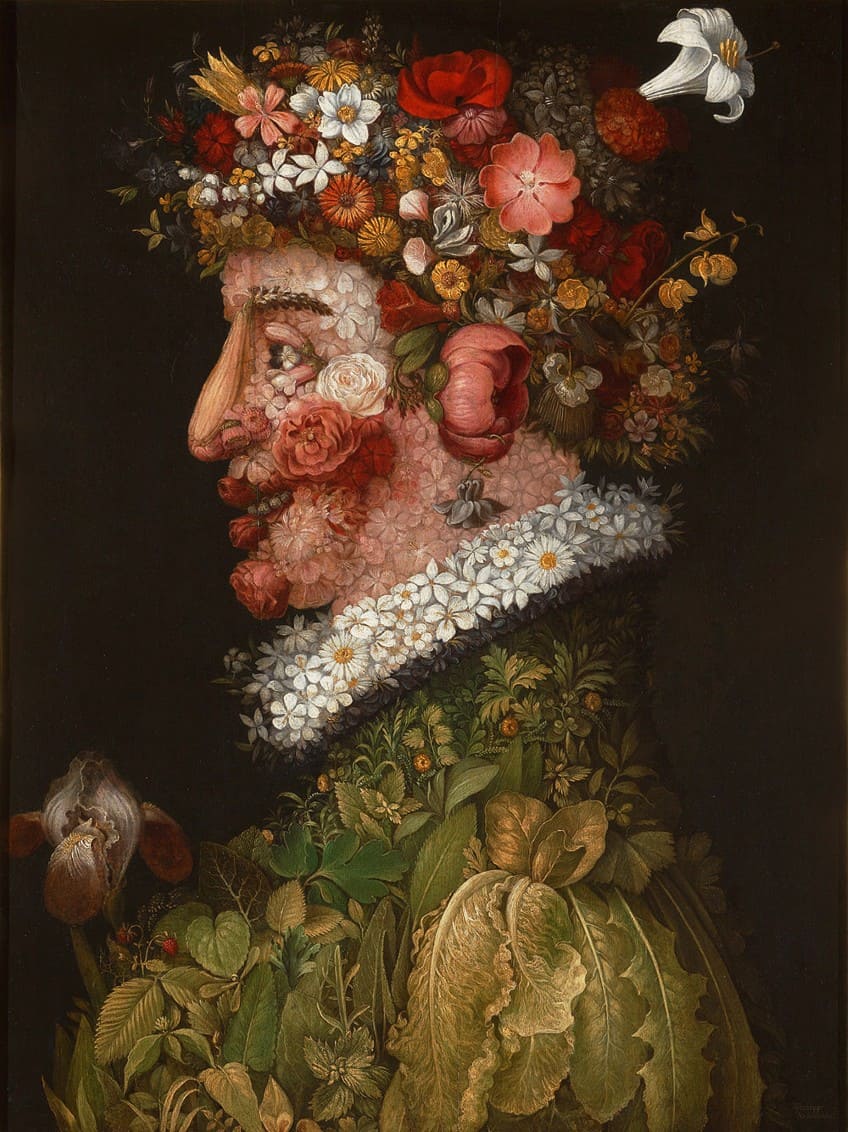
The use of flowers and vegetables was common in Arcimboldo’s practice, of which he included strawberry stems and dandelion leaves for the woman’s dress. The painting is also part of a series of paintings on the four seasons titled Four Seasons, which were created for Emperor Maximilian II.
Spring Bouquet (1866) by Pierre-Auguste Renoir
| Artist Name | Pierre-Auguste Renoir (1841 – 1919) |
| Date | 1866 |
| Medium | Oil on canvas |
| Dimensions (cm) | 104.8 x 80.3 |
| Where It Is Housed | Harvard Art Museums, Cambridge, Massachusetts, United States |
Spring Bouquet is a renowned spring painting by Impressionist painter Pierre-Auguste Renoir, who created the work in 1866. In Renoir’s painting, spring is depicted as a still-life with a luscious bouquet set in a Japanese vase, painted in a painterly fashion to explore the textures and colors of the flowers using a brush. Renoir was interested in the works of 18th-century painters such as François Boucher and Antoine Watteau, whom Renoir studied while working as a porcelain painter.
Renoir displayed an excellent handling of the tonal variation in the work while balancing the light and shadow aspects of the work to truly bring it to life.
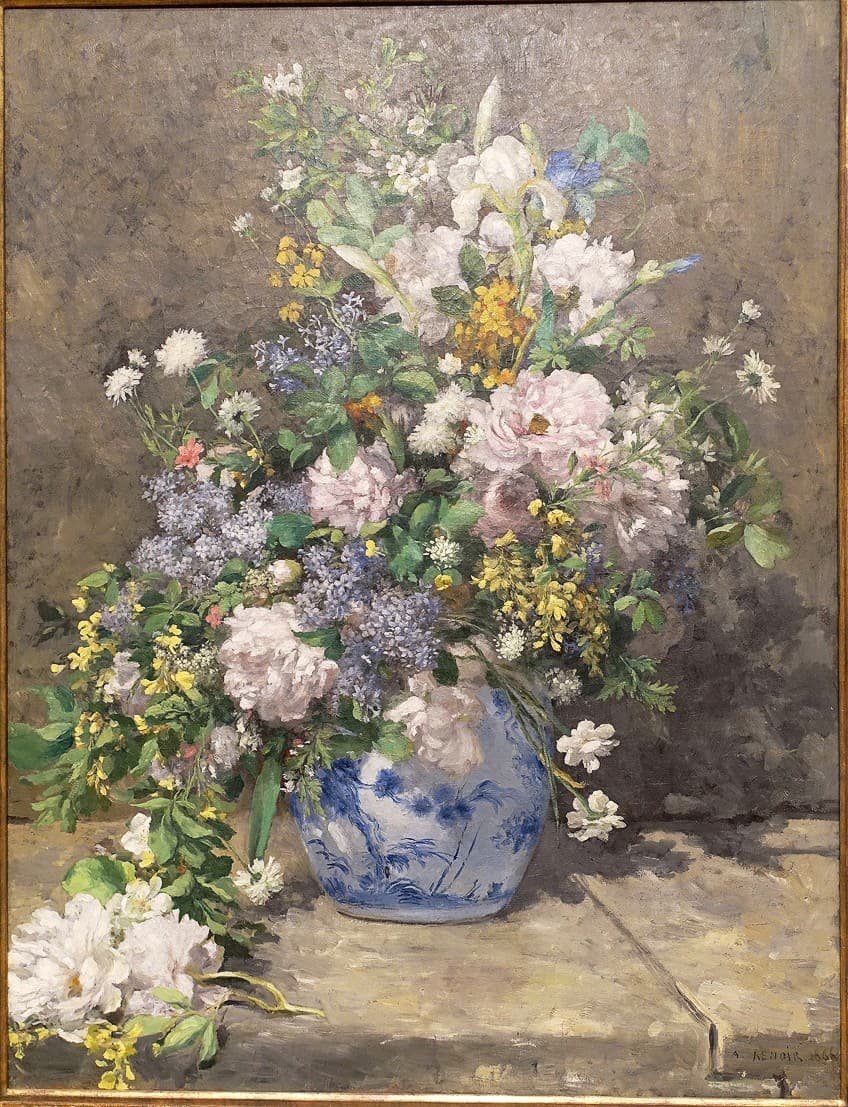
Renoir was also known for including many outdoor subjects in his paintings, which included the presence of flowers and joyful atmospheres, which were associated with springtime. His loose and spontaneous brushwork also conveyed a sense of immediacy and movement, which truly brought his paintings to life.
Springtime (1872) by Claude Monet
| Artist Name | Claude Monet (1840 – 1926) |
| Date | 1872 |
| Medium | Oil on canvas |
| Dimensions (cm) | 50 x 65.5 |
| Where It Is Housed | Walters Art Museum, Baltimore, Maryland, United States |
This serene composition of a woman peacefully reading a book in a lush park was created by Claude Monet in 1872. Monet was inspired by the beauty of the town of Argenteuil, which he moved to a year earlier. Many of his paintings from this time also included scenes of his wife, Camille, as well as his son, Jean, whom he used to develop his Impressionist style.
In Springtime, Monet captures the brilliance of the sunlight as it casts gentle hues of light over his wife, who is portrayed enjoying a book.
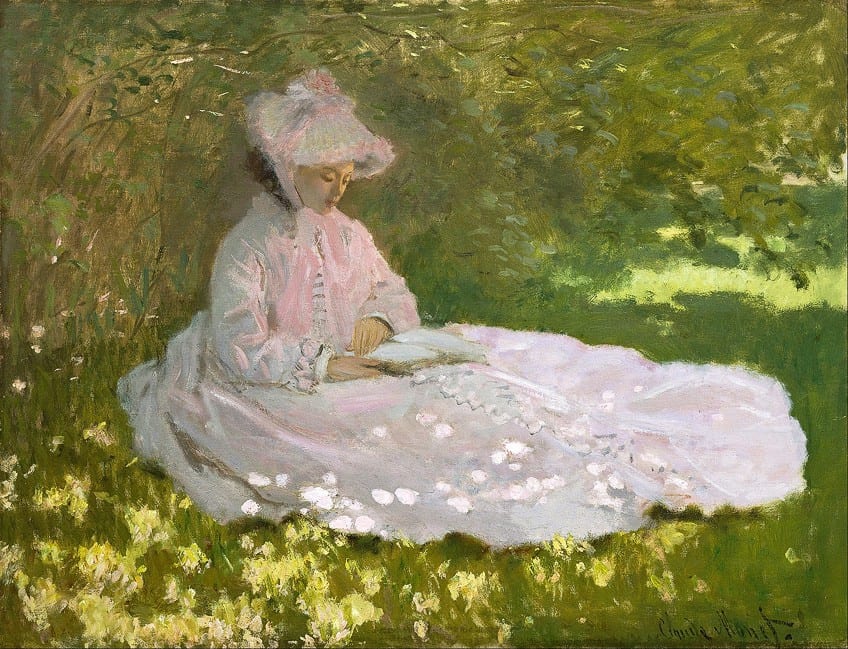
Fishing in Spring, the Pont de Clichy (Asnires) (1887) by Vincent van Gogh
| Artist Name | Vincent van Gogh (1853 – 1890) |
| Date | 1887 |
| Medium | Oil on canvas |
| Dimensions (cm) | 50.5 x 60 |
| Where It Is Housed | The Art Institute of Chicago, Illinois, United States |
This famous spring artwork was created by none other than post-Impressionist painter Vincent van Gogh in 1887 as a token of affection for his friendship with Paul Signac. Van Gogh was inspired by the techniques he encountered in the works of Georges Seurat and Paul Signac during the spring of 1886, which was the last Impressionist show. Van Gogh was also motivated by Signac’s use of bright and playful colors, which encouraged him to broaden his palette and brush style.
The scene in Fishing in Spring portrays a view of the Seine River near Asnières, where Signac used to paint alongside Van Gogh.
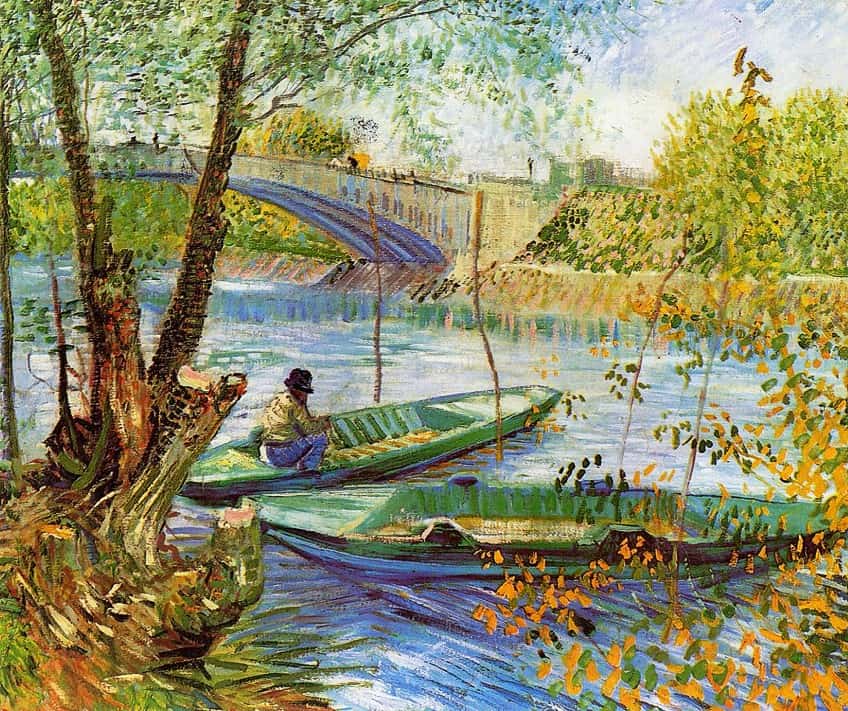
Almond Blossoms (1888 – 1890) by Vincent van Gogh
| Artist Name | Vincent van Gogh (1853 – 1890) |
| Date | 1888 – 1890 |
| Medium | Oil on canvas |
| Dimensions (cm) | 73.5 x 92 |
| Where It Is Housed | Van Gogh Museum, Amsterdam, the Netherlands |
This gorgeous spring painting portrays a Japanese-inspired depiction of an almond blossom tree in full bloom. The painting was created by Vincent van Gogh as part of a series of paintings on the subject produced between 1888 and 1890.
The tree was spotted in Arles at Saint-Rémy and was fused with Van Gogh’s interest in Japanese woodblock print styles.
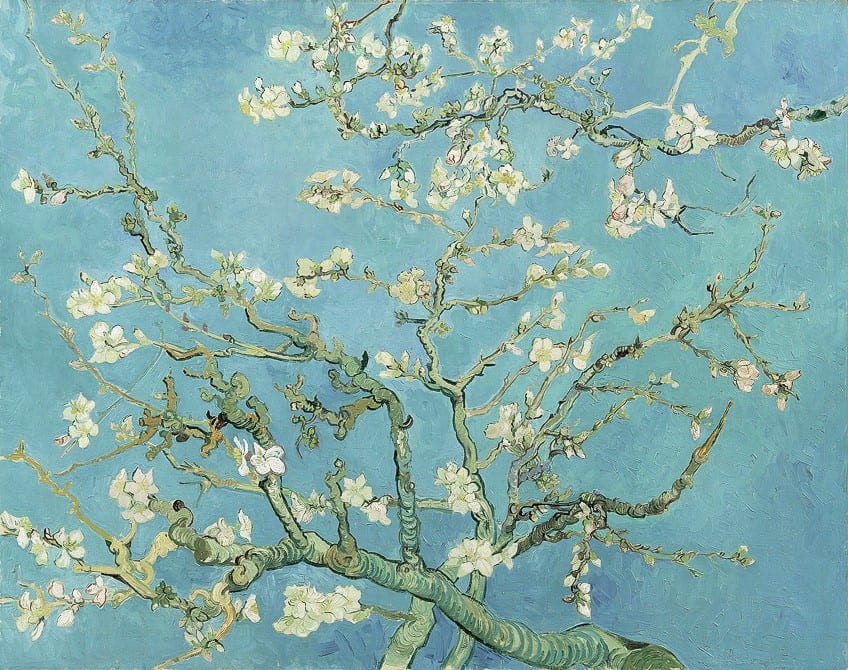
Van Gogh described this influence as “Japonaiserie” and considered the master artists of the East to those who were popular in Europe such as Rembrandt and Vermeer. This painting was an ode to new life and was produced to mark the birth of his nephew. Van Gogh also found much joy in the blossoming tree, which reflected the Japanese style of woodblock art called Ukiyo-e.
Spring (1894) by Lawrence Alma-Tadema
| Artist Name | Lawrence Alma-Tadema (1836 – 1912) |
| Date | 1894 |
| Medium | Oil on canvas |
| Dimensions (cm) | 178.4 x 80.3 |
| Where It Is Housed | J. Paul Getty Museum, Los Angeles, California, United States |
Spring is another famous painting of the season of life created by Lawrence Alma-Tadema in 1894. The spring artwork is currently housed at the J. Paul Getty Museum in Los Angeles and is a reference to the Victorian practice of collecting flowers on May Day. Spring festivals similar to Victorian custom were also practiced by ancient Romans, who celebrated Floralia during spring. This famous oil work also inspired the film Cleopatra in 1934 for the scene of Julius Caesar’s entrance into Rome.
The painting depicts a procession with women and children, as well as spectators who cheer from above in their classical architectural buildings. The procession features people who are decorated with vibrant blossoms for garlands, while some participate in musical performances.
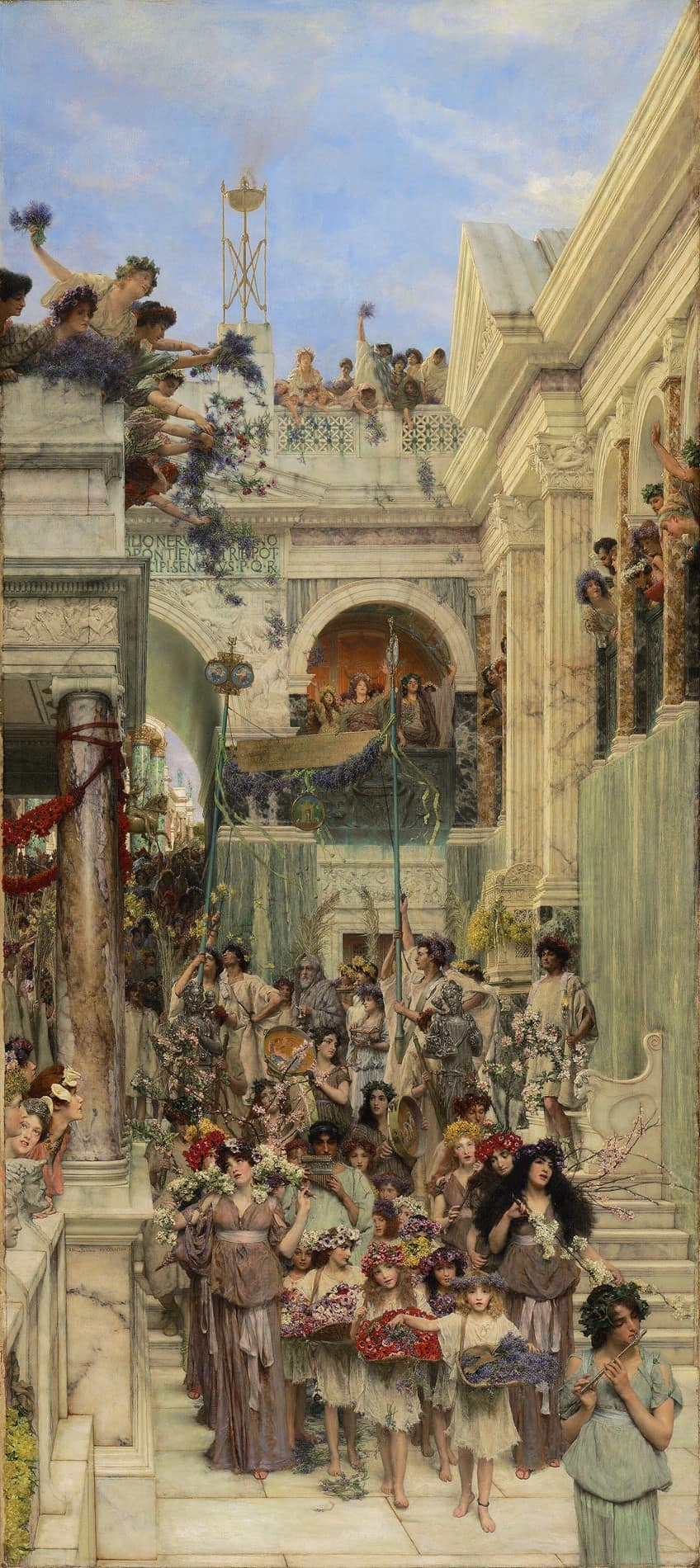
The painting took four years for Alma-Tadema to finish and was purchased by Robert von Mendelssohn. Spring was then exhibited at the Royal Academy Summer Exhibition in 1895 and later at the Paris Exposition Universelle in 1900, where it gained significant commercial success.
The Artist’s Garden at Giverny (1900) by Claude Monet
| Artist Name | Claude Monet (1840 – 1926) |
| Date | 1900 |
| Medium | Oil on canvas |
| Dimensions (cm) | 81.6 x 92.6 |
| Where It Is Housed | Musée d’Orsay, Paris, France |
The Artist’s Garden at Giverny is a classic Monet painting that reflects a splendid view of his garden in the spring of 1900. In Monet’s painting, spring is showcased through a variety of romantic colors such as pink and purple, which are scattered across the composition plane. In the distant background, one can also spot Monet’s home. The Artist’s Garden at Giverny was completed when Monet was 60 years old, an age when he was already incredibly successful, however, his success did not hinder the amount of effort put into the composition and its emphasis on the light shining on the flowers.
During the 1900s, Monet was known to analyze every part of his sanctuary at Giverny, including the sensation, light, and pictorial objects around him, which inspired hundreds of paintings.
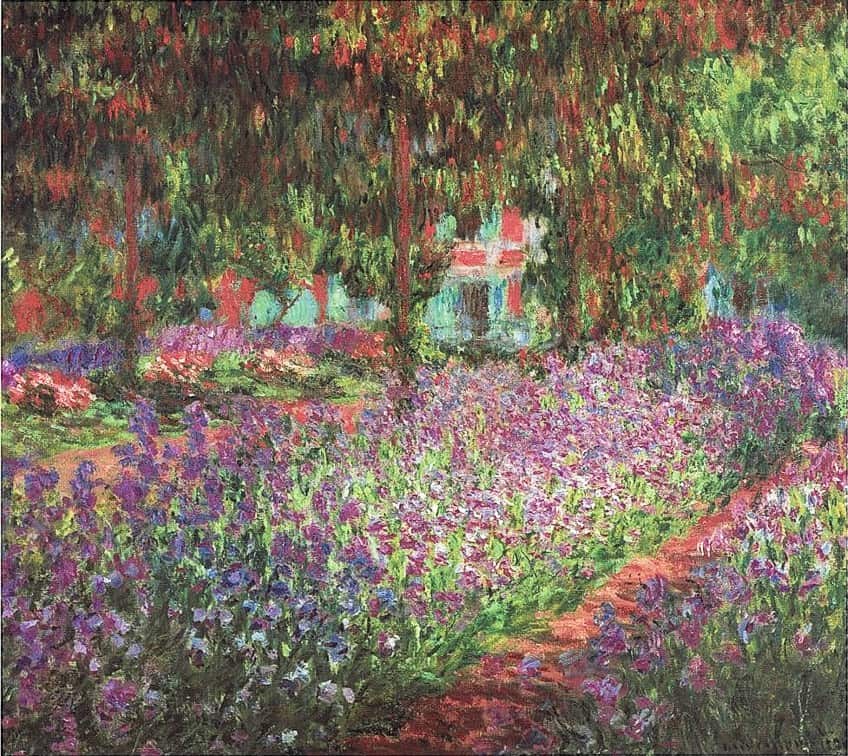
The First Days of Spring (1929) by Salvador Dalí
| Artist Name | Salvador Dalí (1904 – 1989) |
| Date | 1929 |
| Medium | Oil and collage on panel |
| Dimensions (cm) | 49.5 × 64 |
| Where It Is Housed | Salvador Dalí Museum, St. Petersburg, Florida, United States |
The First Days of Spring by Surrealist painter Salvador Dalí is among the most famous paintings of spring created in 1929 using collage and oil on a panel. Dalí used a smooth gray plane to create this surreal composition, which was produced during a period of immense stress for the artist.
The painting describes a tumultuous emotional state of Dalí influenced by his relationship with his own father, who was disappointed in Dalí’s career and unconventional lifestyle.
While the painting does not follow the conventions of spring, it does shed light on an alternative representation that instead focuses on the inner psyche of the artist, who wished to repair his relationship with his father. Perhaps, The First Days of Spring symbolized this hope of a new beginning.
While this concludes our list of the top 10 most famous paintings of spring, we hope that you have enjoyed learning more about these beautiful artworks. It is also worth noting that these artists are also among the most expensive artists in history, whose works have sold for up to millions of dollars. Although spring is a simple subject, depicting its nuanced meanings and symbols is not as easy. In analyzing such common themes, you too can build on your artistic portfolio and create works of art that speak to the heart.
Frequently Asked Questions
What Does Spring Symbolize in Art?
In art history, spring is said to symbolize the beginning of new life or a new start. Spring has also been used to represent cycles of rebirth, renewal, love, joy, purity, abundance, and beauty.
What Is the Most Famous Spring Painting?
Primavera (c. 1482) by Sandro Botticelli is considered to be the most famous spring painting that features Roman mythological figures, including the goddess of flowers, who is the personification of spring.
What Is the Most Expensive Painting of Spring?
Spring (Le Printemps) (1881) by Édouard Manet is considered to be the most expensive spring painting, since it sold for $65.1 million at Christie’s in 2014.
Jordan Anthony is a Cape Town-based film photographer, curator, and arts writer. She holds a Bachelor of Art in Fine Arts from the University of the Witwatersrand, Johannesburg, where she explored themes like healing, identity, dreams, and intuitive creation in her Contemporary art practice. Jordan has collaborated with various local art institutions, including the KZNSA Gallery in Durban, the Turbine Art Fair, and the Wits Art Museum. Her photography focuses on abstract color manipulations, portraiture, candid shots, and urban landscapes. She’s intrigued by philosophy, memory, and esotericism, drawing inspiration from Surrealism, Fluxus, and ancient civilizations, as well as childhood influences and found objects. Jordan is working for artfilemagazine since 2022 and writes blog posts about art history and photography.
Learn more about Jordan Anthony and about us.
Cite this Article
Jordan, Anthony, “Famous Spring Paintings – Top 10 Paintings of the Season.” artfilemagazine – Your Online Art Source. October 31, 2023. URL: https://artfilemagazine.com/famous-spring-paintings/
Anthony, J. (2023, 31 October). Famous Spring Paintings – Top 10 Paintings of the Season. artfilemagazine – Your Online Art Source. https://artfilemagazine.com/famous-spring-paintings/
Anthony, Jordan. “Famous Spring Paintings – Top 10 Paintings of the Season.” artfilemagazine – Your Online Art Source, October 31, 2023. https://artfilemagazine.com/famous-spring-paintings/.



